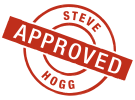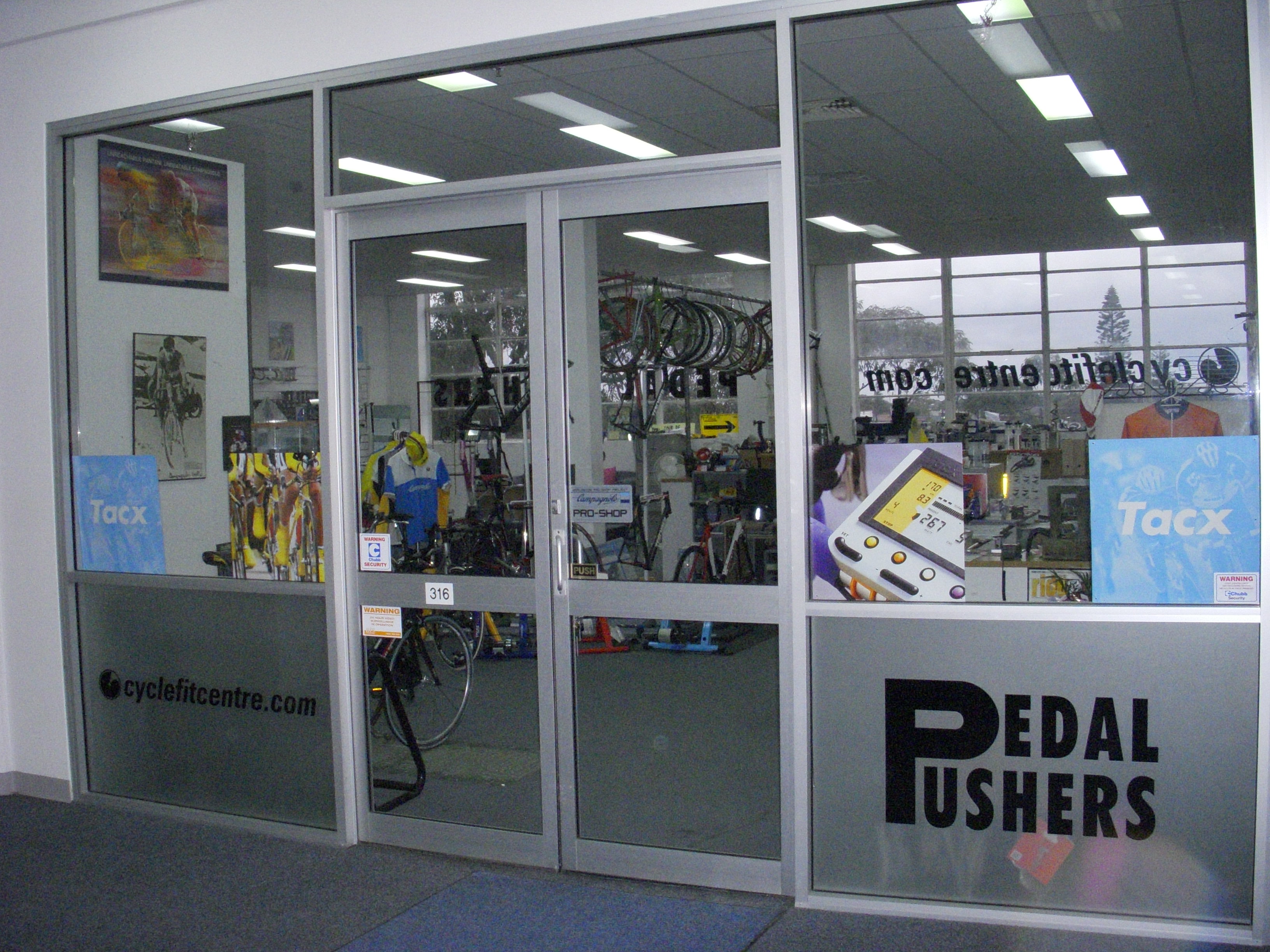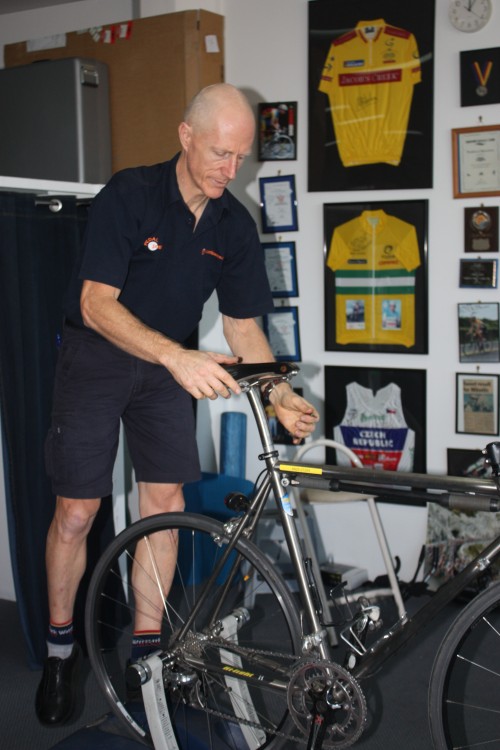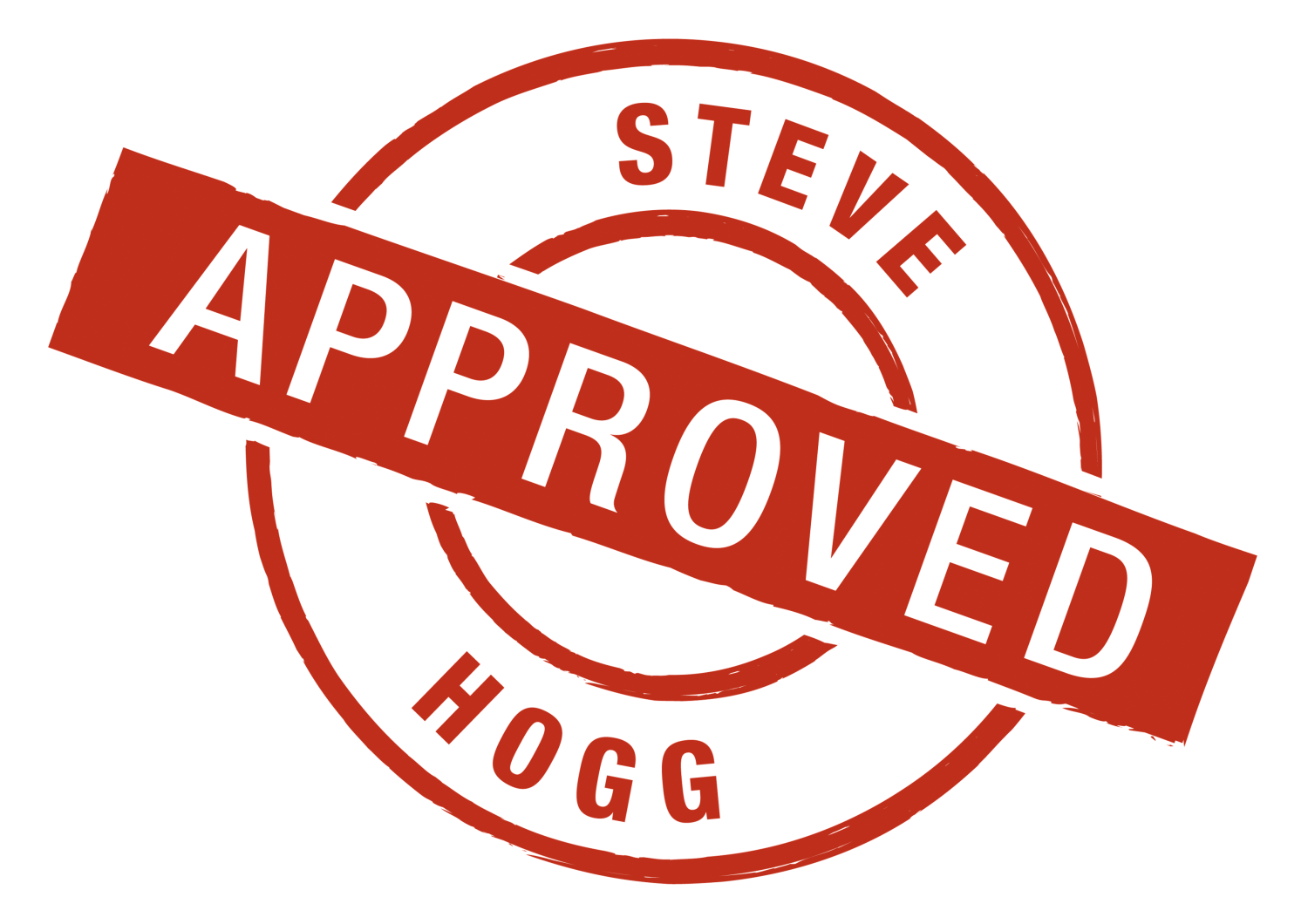Last Updated on December 19, 2012 by stevehoggbikefitting.com
The original post can be found here.
One of our readers, Bill left a comment asking for footage of the prime visual cue for over extension of the legs. In other words, how to tell when the seat height is only a little too high. I have plenty of footage, but uploading to here means that the footage loses quite a bit of resolution. So footage that subtly showed what I wanted to illustrate was much too subtle because of lower resolution. Hopefully the two views below are obvious without being way too obvious.
Click play and I’ll explain below. In both film clips the gent is under reasonable load. In this case, big chainring at 80 rpm but not so big a gear as to sacrifice technique just to turn the pedals.
The first thing to note is that this gent is what I call a toe dipper; that is he pedals with a marked toe down technique. This is not rare but is relatively uncommon in males. More about that below. Focus on the back of the knee. With an ideal seat height, the velocity of the extension of the knee should be a constant. Here, if you look carefully (and the relatively low resolution doesn’t help) you will see a small acceleration in the extension of the knee just before the bottom of the pedal stroke. If you are not used to looking for this it may take multiple views before you see what I mean. That acceleration in extension of the knee means that the rider is losing control of the movement because his seat is too high.
Now let’s look at the left side.
Two things stand out. Firstly, on the left side the toe is pointed more than on the right side. Secondly, the acceleration in extension at the back of the knee is more obvious than on the right side. Why?
There are multiple potential answers. Regular readers will remember that I am often saying that any challenge to a riders’ position will evoke an asymmetric compensatory response. This gent’s response to too high a seat height was to drop his right hip on every right side pedal down stroke. That partly helped the favoured (in this case) right side but the poor old left side was ‘sacrificed’ because the right side hip drop and consequent pelvic shift that allowed it, didn’t rebound all the way back to centre. Meaning the left leg had to reach further than the right leg. There was no other choice on the left side but to point the toe more and overextend to a greater extent than on the other side. See below for the most important view, the rear one.
One more word about our subject above. There is a lot wrong with his position which this footage only partly shows because the aim when filming was to highlight his too high a seat height. When fitting someone I have no set order of changes. I usually tackle the most obvious problems first and gradually proceed to the less obvious or less important with constant checking and reassessment along the way. I initally dropped our friend above’s seat by 15mm. As the fit progressed with changes to cleat position, foot correction, seat setback and so on, he began to drop his heel more naturally, Dropping the heel causes more extension of the knee than pointing the toe so our subject eventually ended up with a 28mm lower seat height than when we started. 3.5 hours after we began he displayed what I call “Joe Average” pedaling technique. That is, unexceptional.
So what I’m saying is that in this case at least, the uncommon but not unknown amongst males, toe dipping pedaling style was brought on by WAY too high a seat height and was itself an attempt at compensating and was not a technique that was natural for him. Sadly, that seat height was the result of a ‘professional’ bike fit.
Seat height is such a simple thing that I don’t think enough attention is paid to it within the bike fitting ‘industry’. The consequences of too high a seat can in many cases be severe. Go to this post and scroll down to the Comments at the bottom until you see the one from Anke. Anke came to see me after changing her seat on and having a bike fitter set the position for her 3 months prior to walking in our door. After a long ride a few weeks post seat change, she developed chronic low back pain on and off the bike. At the time I saw her she was in constant pain that no treatment she had been given by manual health professionals had been able to relieve more than temporarily. Her physio and chiro suggested a low back MRI which Anke had had done just before I saw her, though at that time she did not yet know the results.
I made a lot of smallish changes to her position with the major change being a drop in seat height of 12mm. Anke didn’t think this was a lot, though I did. At the end of the session we hammered Anke on the trainer for 15 mins at a variety of resistance levels and gradients and she was fine, in that she experienced no back pain. That is until she got off the bike.
A few days later she got the results of the MRI; substantial damage with disc bulges pressing on major nerves and has since had spinal surgery as you will read. I am using Anke’s unfortunate experience to highlight just how IMPORTANT seat height is and how SEVERE the consequences can be if it is too high. If you have ANY doubt about your seat height; a few mm too low is a far lesser evil than a few mm too high.
Lastly; my fit customers can be divided into 2 categories. Those who have previously been fitted somewhere or other and those that haven’t. The great majority of each category are sitting too high when I see them for the first time. Not all, but certainly a large majority.
Seat height is often not accorded the importance it deserves because it isn’t esoteric enough or techo enough and doesn’t come in carbon fibre or exotic materials. Seat height is a big deal, particularly if it is too high for too long.
COMFORT + EFFICIENCY = PERFORMANCE
Note: Often, more specific answers to your questions can be found in the Comments below or in the eBooks section and FAQ page.
To learn more about bike fit products offered by Steve, click here.
Do you have a bike fit success story? Please go here to share.
Thank you for reading, return to the Blog page here or please comment below.Comments (36)
Comments are closed.








Dear Steve,
The obvious corollary if I may – how do I know I am too low? Do you have a method of determining when someone is too low and has closed the hip angle too far? I have a colleague I cycle with who complains her position feels strong and fluid on the flat but weak and “grindy” when climbing – she complains she can’t turn her legs over with any fluidity on a gradient.
Thank you so much for this incredibly valuable resource!
Michelle
G’day Michelle,
Follow the method outlined towards the end of the original seat height post.
If that doesn’t work then consider whether crank length is too long. If she struggles to get over the top of the pedal stroke with a sensible seat height, then too long a crank length is the likely (but not only) culprit.
Hi Steve
If you have someone dropping down at the bottom of each down stroke and titling a little to that side as well. They have been like this for years and have worn down the seat foam and even distirted the Ti rail on that side.After adjusting for leg length would you advise a slightly lower seat height initially and then gradually increase that over say 4-6 weeks?
Thanks Tony
G’day Tony,
Firstly, replace the seat with a new one. Next, if there is a bone length difference, shim the cleat of the shorter leg. Then check psoas, gluteal, hamstrings and QL tonicity on each side. A typical pattern of compensation for a cyclist with a shorter leg is tighter psoas, gluteals and hamstrings on the shorter side and tighter QL on the longer legged side. However, there are plenty of exceptions and your guy may be one.
The muscle imbalances need to be addressed because the embedded motor patterns of the rider plus any functional differences between sides will tend to cause the same hip drop, even when the shorter leg is shimmed. Don’t assume existing seat height is fine and yes, be conservative with seat height to eliminate it as a challenge to position.
Don’t believe the stuff you read about “compensate for differences in femur length by 1/3 and lower limb differences by 1/2” as my empirical experience tells me that is formula approach bullshit. Compensate as necessary to gain the same degree, or as close as possible to the same degree of extension at knee and hip on both sides at bottom of pedal stroke. If this can’t be achieved, then address the left / right differences in the muscles listed above (as well as any others that seem implicated).
Check the feet as well because often leg length differences lead to significant differences in foot morphology. You need to make sure the rider has plenty of arch support in their cycling shoes. Esoles Supportives are the best out there and it is worth your while reading the post on Arch Support.
I hope this helps.
Thanks Steve. The videos are very helpful. I am in a similar boat – due to functional limitaions (tight hamstrings, flexibility issues due to disk issues at L4 and L5) I find an “average” seat height too high. I have been professionally fitted twice (two different systems that you and I have emailed about) and both times they raised my seat. Post fitting, after rides, both times I have dropped my seat. To be fair, under load I drop my heels a fair bit and push back on my saddle which both add to the problem.
Using your “self-fit” method I keep coming back to a position that is about 13mm lower than the “recomended” level. I am just amazed at how many “professionals” keep coming back to the crutch of formulas even when they clearly do not meet the needs of the client.
G’day Craig,
When you say “to be fair, under load I drop my heels a fair bit …………etc” as though that is an excuse for your seat height being set too high by professional help you’ve sought; you’re being too nice. A bike fitter can approach their task in one of two ways. They can blindly apply a system in which case they are a process worker, not a bike fitter, OR they can take an individual approach to each client. I won’t let a fit client out the door until I’ve hammered them at high load and heart rate (relative to their capabilities) for a sustained period. The test of a position is how well it holds up under load. This is *the* most important part of the fit. I’ve set the position and want to see how ‘right’ it is for that person. The *only *way to be sure is to see what happens when the rider is fatiguing and fighting a bit. If the subject spends too much effort trying to maintain their position rather than propel the bike, more work is necessary.
As soon as the goniometer comes out……………be concerned. The use of a goniometer says in effect ” I don’t know how to judge seat height for this
individual, so I will rely on a static average that may or may not be appropriate for this person, the way that they function and their needs”
As I said; process work, not bike fitting. I see so many people who have complained to their fitter about some aspect of a previous fit and been told words to the effect “………….. the numbers were right, so you must be the problem”. As a cop out, that’s world class.
Firstly, Thank you Steve – I purchased your DVD “Sitting Pretty” some 12 months ago. Fitting my road bike for triathlon (clip on Aerobars) I found myself moving my seat back and down (also shortening my stem and raising aero pads)- until I reached a balanced position, and more so, a comfortable one – reducing almost all perineal discomfort and knee pain. I am now in the top 3% of bike splits (from top 25%) with the same training volume.
Quick question – why is it that most pros and triathletes for that matter still favour the forward position? Surely they’re sacrificing balance, and hence power and comfort for aerodynamics.
Thanks Steve
G’day Brad,
Coincidence is a wonderful thing! I’m planning my next 3 posts now. The first will be a long promised answer to a Romanian reader; Mircea. Then I was planning one on Seat Setback and then TT and Tri position, which by the way are not the same thing in my view.
Forward position is a funny thing. We all recognise it when we see it but it is hard to define. If you bear with me for a few weeks I will attempt to answer your question in detail by way of the TT / Tri position post.
Interesting about toe down position. What effect does cleat position and/or saddle setback play in this if any or is it always height?
G’day Duane,
I’ve got a post on pedalling technique coming shortly and I don’t want to pre empt it. However, in a nutshell, firstly you have to determine whether the toe down technique is the riders’ natural technique or a compensation for too high a seat height. Assuming the the technique is natural and will stay with the rider, cleat position can creep forward somewhat. As far as seat setback goes, the major vector on the pedals with a toe down pedaller is to the rear. That means they have an increased tendency to tip their weight forwards (Newton’s 3rd law etc) and all other things being equal (which they never are anyway ) will need to sit further back than their hypothetical heel dropping or Joe / Josephine Average pedalling twin.
Hi steve,
Is it possible (or likely?) to be more powerful at a slightly higher seat height even though it would be “structurally” wiser to sit lower?
G’day Eric,
the answer to that is a semantic one. When you say “powerful”, it is impossible to talk about power without talking about duration. If we are applying a single pedal stroke, greater extension of the leg (without being stupid about it) equals more power for that single stroke because the leg is extending through a greater range and applying force for a greater distance.
If however, you are talking 4,500 – 6000 pedal strokes per hour, with the possibility of severe load from time to time, then control of movement becomes the priority. There is no point being more ‘powerful’ for a brief period if you break down in longer rides because the rider cannot control the movement well for the length of time and load required.
So I am saying that the rider should sit as high as they comfortably can relative to the time that they need to apply force to the pedals at the cadence they need to use and the type of riding they tend towards. Everyone can sit higher at 100 rpm with light load on the pedals than they can at 80 rpm with heavy load on the pedals. That means there are two potential options. Set your seat height for higher cadence / low load situations and every time you hit a hill, jump off and quickly lower your seat.
OR
Have your seat height preset at the lowest that you are realistically likely to need for any sustained effort.
I’d choose and advise others to choose the latter. What that seat height ends up at is varies widely *even for people with the same length inseam and same size feet *because of differing pedaling techniques and differing functional capabilities.
that makes sense. thank you.
how do you know what someone’s natural pedaling technique is, though?
you said the gentleman in your video was pedaling toe down because of the high seat. if you drop the seat enough (too much for example), wouldn’t you expect just about everyone to adopt a heel-dropping stroke?
G’day Eric,
good question and the answer is only if you get it wrong. Setting seat height, like every other positional parameter, needs constant checking and reassessment after any further changes to other parameters. For example; if my assessment is that the rider is too high, I drop the seat to what I guesstimate is appropriate and then put him under high load. If the rider can reach fluently through the bottom of the stroke, great. Raise the seat a few mm and see if he can still do so. If yes, raise again and retest.If not, then drop the seat until I reach what I am looking for.
Check both legs. If there is a difference, why? Is the pelvis tilting? Will dropping the seat further have a beneficial effect on that?
And so on.
This check / recheck of seat height *under high load* continues after every further change. After any change to seat setback, angle relative to horizontal of seat, addition of wedges, arch support, shims, cleat angle on shoe,changes to bar shape or placement or reach and so on, I check seat height again under high load. By the time I’ve finished this exhaustive process with the rider, I am confident that the pedalling technique that results is natural for them and not being forced upon them. A small minority of riders will adapt further over time; weeks or months and need another check. I have learnt to read the signs and it is these riders that I get back in after 6 – 8 weeks just to check. Occasionally I’m caught out in the sense that someone whom I thought would maintain a pedalling technique changes their technique over time. If distance is a problem (a large percentage of our fit clients are interstate and international) I use video to sort it out. This happens from time to time but isn’t common.
Hi Steve
I eagerly await the sister post to this one with the title of:
Seat Setback – How Hard Can It Be?
thanks!
Yuri B
Melbourne
G’day Yuri,
It’s up now. Click on
this: http://www.stevehoggbikefitting.com/blog/2011/05/seat-set-back-for-road-bikes/
Can you please recommend a bike fitter in the Denver/ Boulder Colorado area. I have been riding for over 20yrs with a good portion of that spent as a cat1 in the US, so I am pretty stuck in my ways, and position. I have been suffering from hip problems (FAI) that have kept me off the bike but am looking forward to getting back on after a laberal reconstruction surgery. So, I am now curious if there isn’t something I can improve with my position in consideration of my hip and back.
Thanks, Nick
G’day Nick,
I have no first hand knowledge of your area but the gent I
keep hearing good things about is a physiotherapist named Mike Kohm. His
contact details are
Mike Kohm PT, BS, CYT
Neuromuscular Strategies LLC
@ Denver Whole Yoga
1735 E 17th Ave
Denver, CO 80218
720-352-0678
Hi Steve, great blog, really interesting.. I read this post (and the pedaling technique one) with great interest – I think I am a toe dipper as you refer to it and have a question on the effects of different techniques on the force being put through the patella tendons. I have been unable to ride properly (was doing about 50-80 miles a week beforehand) for 18 months due to Patella Tendonosis/Tendinopathy in both knees.. I’m not 100% sure what brought this condition on all those months ago, could have been excessive cycling could have been something else, and although I seem to be able to do some other sports (e.g. Hockey) Cycling is still an issue. I’ve recently started to try get back out on the bike (building up to gentle 12 milers) but is seems that as soon as I pedal with any significant force (even against the wind for example), as opposed to just easily spinning away, my Patella tendons play up the day after for several days of pain…so just wondering if you think my toe dipping technique or any other bike fit parameter could be causing this trouble and over loading the tendons. I did have a pro bike fit session a few years ago, but based on your blog maybe that was not as good as I thought it was at the time.
Thx
Ian Hutchinson
Cambridge
UK
G’day Ian,
If you can play hockey okay but not ride a bike, then some factor(s) of the interaction between you and the bike is likely to be the problem. It is unlikely but possible that your toe down pedalling technique plays a part, but it would not be in isolation. There have to be significant issues elsewhere. The obvious potential culprits are:
Too low a seat height.
Too high a seat height
A seat that is too far forward
Any factor that prevents your patella from tracking well. This can be poor bike position, poor cleat angle, lack of foot correction or inappropriate foot correction, poor flexibility in hips, lower back, quads, hamstrings or calves,
or any combination of these things. Do any of these strike a chord with you?
Even so, hockey requires a lot of start / stop running and changes of direction and as you can perform okay on a hockey field, I suspect your position on the bike is the problem.
Is there the opportunity in Cambridge to find a quality bike fitter?
If you can find a good one, preferably with a health science background or with good knowledge of functional anatomy, they should be able to diagnose and solve the problem. If you can’t find one locally, talk to Scherrit Knoesen of The Bike Whisperer in Ealing, London. He should be able to sort you out.
Steve,
I was wondering if you have any experience in fitting a rider on Rotor Rings or O’symetric chainrings? What would you do in looking for the “acceleration” of knee before extension? Also, I was wondering if the use of Rotor or O’symetric rings would call for a different saddle height. Please let me know. Thanks.
Marc
G’day Marc,
I’m not a fan of O’Symmetrics. They either work for the rider or they don’t work and there is no means to adjust the phase in small increments as there is with Rotor Q rings. I am a bit of a fan of Q rings and use them myself. The majority seem to think they are of benefit. Re seat height, no difference to that of a round ring.
Re knee acceleration. When first fitted there is an obvious acceleration / deceleration pattern to the extension of the knee. Once the rider has spent several weeks on them, this on / off pattern diminishes and near disappears.
The other thing is the phasing advice given by Rotor is wrong for a significant number of Q ring users. Rotor suggest that the further back the rider sits, the lower the number of the position they need to use. I have found that it isn’t seat setback that determines the ideal chain ring orientation, but seat height. Simply, the less knee extension a given rider has because of hamstring inflexibility, a rearward cleat position or whatever other reasons, the higher phase number that works best for them. So many people should be using Position 4.
Hi Steve,
I have been fit several times, the most resent by Retul. My right knee tends to do a S like curve, inward pedaling down and outward coming up. This has caused me some discomfort at times. I am 1.8m tall with a 90cm inseam. My saddle height is currently set at 79cm. Would lowering my saddle prevent the S like pedal stroke? I also have Shimano R310 with Specialized footbeds and a varus wedge. I currently ride with a Shimano fixed cleat because I noticed my foot tends to move outward the longer I ride with a floating cleat. Any thoughts? I look forward to hearing from you. Thank you!
G’day Levon,
There are only a finite number of possibilities for what
you describe. They are –
1. If seat height is too high, you won’t sit squarely on the seat and equally overextend both legs. You will pick a side to protect (by dropping and rotating that hip forward) and a side to sacrifice. Most often it is the right side that is the protected side and the left side that is sacrificed but I’ve seen left side dominant versions of this and you may be one and if you are, what you describe can result. If in doubt, drop your seat say 10mm and see if the situation improves. If it does, you then have to decide whether you can ride effectively at that 10mm lower seat height and that will take several weeks to determine.
2. You’re seat height is more or less okay but you are not sitting squarely on the seat. The most common reason for what you describe for your right leg is that you are dropping the left hip and rotating it forward on the left side pedal down stroke. This is not uncommon. If you are doing this, then as the left hip drops on the left side pedal down stroke, the right knee will move outwards as you describe on the right side up stroke at the same time. Then as on the left side pedal upstroke, the right hip rebounds back towards the centre line and moves in on the right side pedal down stroke. Solution? Diagnose the problem with an observer or by filming yourself from the rear overhead position with your shirt off while cycling on a trainer and find out why you are doing this. It may be that you have a shorter left leg or
are much tighter on the left side.
3. Something is very wrong with the right hip. It could be Perthes disease
which is a malformation of the femoral head or other similar issue. Before
getting too worried, while possible, this is probably the least likely
possibility, though I see it from time to time.
Lastly, I’m not a fan of fixed cleats used as you describe. They are a band
aid solution and sooner or later the more fundamental issue will bite your
harder. You need to find the root cause of the problem.
Hi Levon – To weigh-in on what Steve just said, I use to be the same way in regards to pedals. Please have a look at question 1 on the FAQ page of the website. The Foot Correction series should help you out quite a bit (as will the other posts)!
Hi Steve,
I followed your instructions on how to align my cleats. Now I am wondering if I should move my seat forward or backwards since my cleats are now further back on my shoe. I have also switched to a 6 degree float cleat. Thank you for your advice.
Levon
G’day Levon,
Seat setback is a separate issue to cleat position fore and
aft. Complete the test mentioned in the Seat Setback and you will be fine whether that leads to a change in seat setback or not.
Hi Steve,
How do you mark up those dots on the riders back to ensure they are perfectly aligned?
G’day Kasper,
Most of these film clips are shot so as to highlight to
the rider what they are doing. Many are completely unaware that they are unstable on the seat and the video footage often comes as a shock to them. The marks on the subjects backs are not anatomical landmarks but are placed there to catch the eye of the viewer and highlight the extraneous movement only.
Hi Steve,
Thanks. A few weeks ago I lowered my seat about 25mm, which caused my saddle sores to go away immediately. However, I still have a few problems I can’t seem to sort out.
I don’t seem to “balance” properly, even with my seat all the way back on a 25mm setback seatpost.
I get a strange cramp-like feeling in what I think is in the outer glute/quad muscles. It starts high, and then gradually travels lower and further back.
I have made a small video, where I try to point out the problem areas: [edit: video removed]
I would be happy to her your thoughts.
G’day Kasper,
While I am happy to give general advice at no cost, video
analysis is one of the things that I do for a living and goes beyond what I am prepared to do for free. If you wish to go the video route, contact me via the Contact tab at the top of the page and I will send you the pertinent questionnaires.
Hi Steve,
I didn’t know, sorry. I completely understand. I will experiment a bit more. I don’t feel the problem is severe enough at the moment, to be worth the $300+ video fit cost.
But if it’s persistent, I will definitely keep that option in mind. It’s a nice option though for us that would otherwise have to travel across the globe to see you.
Hi Steve,
I went through your eBook collection and DVD (this is excellent) one more time. I ended up lowering my seat a further 4 mm and pointing the nose slightly up, as you suggest on the DVD. This change meant that I can now balance equally well with 85 mm. setback as I can with 110 mm.
Obviously I then had to change to a longer stem, which also raised the bars another 15 mm. And while I have only had a short ride, this seems to have helped on the cramped hip/quad muscles.
G’day Kasper,
I was thinking about what you wrote last night. On the rare
occasions that I’ve had clients with pain where you describe it, it has been as the result of too much seat setback. What you’ve said above seems to confirm that in your case. Keep on with it.
Hi Steve,
I have been reading your blog for quiet some time now and has been of very useful information (although it makes my head hurt sometimes) I have had problems over the year with saddle height and aft/fore positions. Basically the problems occured when I started racing and got in to the longer races 100k +……
I started to always get cramp in my Sartorious muscles (both sides) and tried many physios to get to the root of the problem. None of this helped and then after spending many hundreds of pounds on bike fits I still had no joy. The bike fit “speciallists” were telling me to open up my hip angle and knee angle as not to bring the Sartorious muscle in to play, It helped a little but was struggling with too high a saddle and too much set back, I was also cramping else where due to over extension.
My saddle has beeen up and down forward and back for 3 years and I still haven’t found a position I am happy with.
Mark, Scotland.
G’day Mark,
Sartorius cramping is an interesting problem because I’ve
only come across it a couple of times in 20 something years! I don’t have an off the top of my head answer.
If the pelvis is fixed in space which it should be while sitting on a bike seat, the sartorius flexes, externally rotates and abducts (moves outward from the centre line) the femur (bone of upper leg) and flexes and internally rotates the tibia (major bone of lower leg). To me that seems to suggest that if your sartorius is cramping, presumably from being overstressed, that there is some constant challenge to the plane of movement of your legs that the sartorius particularly, is fighting to overcome until it tires and cramps.
So the solution could be a range of things or combinations of. Here’s what I suggest. Read these posts and act on them in this order –
1. How To Avoid Bike Fit Hell (and revisit this after every change to your position that you make)
2. Seat Height – How Hard Can It Be?
3. Seat Setback
4. Power To The Pedal – Cleat Position
5. Foot Correction part 1 – Arch Support
6. Foot Correction part 2 – Wedging
7. Foot Correction part 3 – Shimming (though the cramping on both sides
suggests that at least you are functioning more or less evenly.
8. Behind Bars
If you take to heart the instructions in How To Avoid Bike Fit Hell and
then methodically work your way through the posts I’ve suggested, I think
it likely that you will solve your problem. It will take some time though.
One other thing; do you stretch regularly?
If not, now is as good a time as any to start but make sure that you get
good advice or use a good book as a reference.